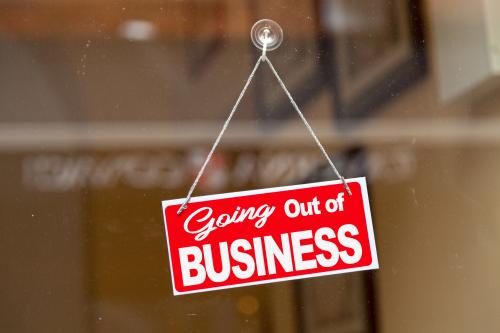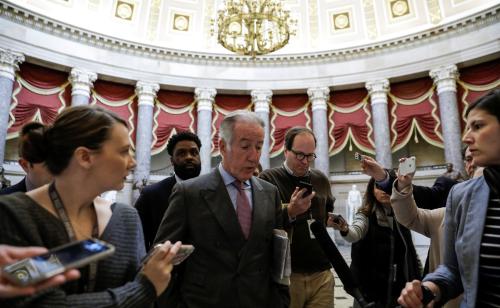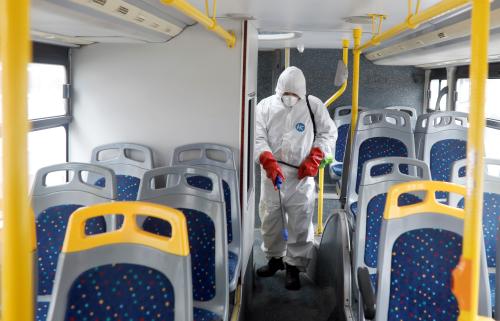Strong public health action is required to defeat the virus that causes COVID-19. At the same time, economic policy is also urgently needed to stem the social damage of the pandemic. Here I describe a proposal that would provide a timely, proportionate, and administratively straightforward response. If implemented, it would allow workers and businesses to engage in social-distancing without threatening their livelihoods.
Federal Government compensation for income loss
The basic proposal is as follows:
- From April 1, businesses would have the option of reporting to the IRS a measure of lost revenue, for which they will receive 95% reimbursement. The formula can be simple. Business revenue from January and February of 2020 will be averaged and compared to revenue for March. The difference equals the proxy for lost revenue.

- Businesses can submit these data to the IRS on a simple COVID emergency relief form.
- They will then be reimbursed by the IRS within seven days of submitting, unless flagged for high likelihood of potential fraud.
- In exchange, businesses will have to agree to meet their payroll obligations from February and pay their fixed capital expenses (e.g. rent and utilities). Failure to comply will result in substantial penalties.
- IRS will need additional resources for post-crisis auditing as well, and businesses should be instructed to save documentation of the bank statements and other records used in their calculation. The same process will be available to self-employed workers, defined broadly as any worker who receives at least 15% of total monthly income (for January and February 2019) from income sources that would be reported on Schedule C forms or Schedule E, which would include people who rent out their properties to tourists. These workers would submit a nearly identical form designed for self-employed workers or those who rent out real estate property.
- This program would last for at least three months and payments would be processed each month. Thereafter, the program could be halted or continued at the discretion of the U.S. Treasury Secretary based on public health determinations about the necessity of maintaining or relaxing social distancing.
The precise cost of this program is impossible to know in advance, but I estimate it would be around $500 billion, given that social businesses account for only 9% of GDP and the program would be temporary (see below). That makes it comparable in size to the $850 billion proposal put forward by President Trump on March 17, and leaves room for other spending initiatives to complement this proposal.
Big, proportionate, flexible, simple: the help needed right now
The benefits from this plan would be considerable. No one would need to lose their job or income source as a result of the COVID-19 outbreak. This funding would entirely eliminate the economic harm that would otherwise hit social businesses (e.g. those in tourism, restaurants, entertainment) and prevent a major economic hit on ancillary businesses. It would also prevent a collapse in the real estate market, by allowing people engaged in both the commercial real estate and residential rental industries to pay their mortgages.
The benefits would be proportionate. Businesses forced to close to benefit the public will face extreme loses. Many other businesses will gain or be unaffected by the crisis. This proposal channels money to where it is needed. This proposal also incorporates the geographic disparity in economic damage by giving exactly the right amount of extra compensation to parts of the country—such as Seattle, Washington and New Rochelle, New York—where businesses are most affected by social distancing.
The benefits would also be timely, relying on the IRS payment system, which is well-equipped to handle it. To allow for the surge in processing, the tax filing deadline for 2019 could be extended for six months.
The benefits would be administratively simple. No new entitlement program needs to be created or even expanded, beyond their normal functions. State and local governments need not get involved. Only one agency—the IRS—is needed and two additional forms.
A different kind of economic crisis: no bubble, and time-limited
The SARS-Cov2 pandemic which has caused COVID-19 is resulting in severe health and economic damage globally and in the United States. Previous outbreaks of coronaviruses, such as SARS, lasted for roughly three months and caused effects on GDP on the order of -2.3% for the worst affected country, in this case Hong Kong. The economic damage will likely be much larger for COVID-19 in the United States, given the larger number of eventual cases per capita. Italy, at the time of writing, has already reached double the rate of infections per capita relative to Hong Kong’s experience with SARS.
An overwhelming majority (86%) of Americans polled by Gallup in early March believe that the coronavirus will have a very or somewhat negative impact on the global economy. Around the country states and local governments are forcing the closure of customer-facing “social businesses.” By social businesses I mean those in sectors linked to tourism, travel, restaurants, and entertainment, where being among large groups of people is an inherent aspect of the business. Almost everywhere, citizens are adhering to the advice of public health experts and the President of the United States to stay home. Many owners cannot possibly meet their expenses—including payroll and capital expenses—for any extended period of time.
What makes this pandemic-induced crisis is distinct from recent macro-economic crises in two key ways. First, there is no underlying bubble (in technology companies or residential mortgages, for example) or massive misallocation of resources that underlies the cause. In such cases, prices must inevitably fall—such as the price of housing or technology stocks—to correct the bubble, and fiscal policies can help artificially boost demand and alleviate the fall.
With the present crisis, the economic effects are entirely the result of mandatory and voluntary social distancing. The services of social businesses have gone from being considered normal to toxic. Giving people extra money will not induce them to break a travel ban or go to a restaurant that has been shut down.
Second, this crisis will pass, even as the duration of the crisis is determined by biology and public health, rather than markets. Evidence from past corona-virus epidemics suggest that the peak number of infections usually tends to occur within three to four months of the outbreak’s start. Modeling exercises for COVID-19 are consistent with this timeline, though there is still much to learn about this particular pandemic. With aggressive social-distancing, epidemiologists model that this pandemic can be stretched out, reducing mortality and easing the pressure on hospitals and medical providers. In the case of the 1918 Spanish Flu outbreak, cities that implemented more aggressive social distancing reduced mortality rates by half, extending the epidemic from two to three months. These timelines are consistent with epidemiological modeling work published in top scientific journals, which show epidemic durations lasting between 2 and 4 months, depending on how successfully countries slow the growth curve.
Among the reasons economic effects wane is that once people have the virus and recover, their susceptibility to the disease will likely be greatly or even entirely reduced (though scientific research is needed to establish this definitely), eliminating the motivation for social distancing. Eventually a vaccine will become available, which would eliminate the motivation for social distancing for the un-infected population.
Federal reserve interest rates and tax policies will have no effect on whether social distancing is practiced or not or for how long. Leaders at the Centers for Disease Control, World Health Organization and other public health experts will set the national and international agenda, not economists. The proposal outlined here is closely tied to the economic effects of social distancing, which makes it closely tied to the outbreak itself and public health officials guiding the response.
The short-term nature of this crisis means that providing the aid will be affordable and practical. Other economists have emphasized that government borrowing to prevent an economic collapse is both sensible and affordable, especially with the very low interest rates and generous borrowing terms given to the American government by international investors.
Building on Saez and Zucman
The plan outlined here draws heavily on ideas first set out by economists Emmanuel Saez and Gabriel Zucman who drew up a proposal for making the government the buyer of last resort. They argued for direct transfers to businesses which shut down and individuals who stop working. They estimate costs of 3.75% of GDP (around $800 billion) after assuming a 30% reducing in GDP for one quarter.
Saez and Zucman would have businesses tally up the costs of “hibernation,” meaning maintaining the business’s payroll and necessary capital expense (e.g. rent and utilities). They would also have idle workers apply for a special form of unemployment insurance that allows them to remain employees. A strength of their proposal is that it can run through existing unemployment insurance system, which is well positioned to administer a large number of claims and payments at the state level. A potential flaw is that it could overwhelm state offices.
What is unclear about their plan is who would pay workers and who would apply for payment. If the workers are paid through government unemployment insurance (which compensates 50% to 60% of their income), then the business would have no need to report payrolls as an expense and would not receive money to meet those expenses. In this case, the business would only be compensated for capital costs.
One concern is that it is unlikely that 50%-60% reimbursement rates will be enough to sustain households with little savings. Data from the Consumer Expenditure Survey shows that the average households with income at or below the median ($54,000) has to borrow to meet annual expenditures. That leaves no room for a steep drop in income, even if for three months.
Three reasons why $1000 a month is not a good idea
Another proposal to provide relief would give $1000 to every American adult. This has been proposed by Senator Mitt Romney and former Obama-administration economist Jason Furman. The total cost would amount to $252 Billion. While that aid would surely be useful to many Americans, and the simplicity of it would facilitate timely administration, there are three problems with this proposal: It is unfair, inefficient, and inadequate:
- First, the aid is not proportional to the harm. As of writing, several states have ordered the closure of bars and restaurants, completely eliminating revenue. Other cities have done the same. Meanwhile, some companies, like Amazon, are ramping up hiring to meet growing demand.
- Second, a large portion of the aid would be wasted on people who do not need it. The Consumer Expenditure Survey shows that the average yearly savings from households earning at least $70,000 (who are the 70th percentile of the income distribution) is $7,000 and rises to $64,000 for those in the top decile. This suggest that many of these households could weather 3 to 4 months of reduced income. If one accepts that the bottom 70th percentile of the households need aid much more than those in the top three deciles, then $117 billion of the aid money would be largely unneeded. This point has been made by Treasury Secretary Mnuchin.
- Third, $1000 is not nearly enough to replace the income of most workers whose business has been shut down as a result of SARS-Cov2. Median individual income for workers receiving income from employers is just over $32,000. $1,000 would not even cover one month of lost income, let alone 3 to 4 months.
A larger cash plan has been put forth by Charles Schumer and several other Senators. One of these proposals would provide cash payments of $2000 in cash to every person and adult with individual income below $90,000. This would cost at least $500 billion in total, but despite the income cutoff, it would face the same problems. Many people would get checks despite being completely unaffected by the virus, and the payment would be inadequate for those whose business is shut down. Also, even some higher income individuals in affected industries would be forced to stop paying their commercial and residential mortgage, leading to a potential collapse in the real estate markets and balance sheets of financial lenders.
Other plans have suggested massive loans to businesses with generous interest rates and pay-back periods. That would be better than nothing, but it is unfair to ask businesses (and their employees, indirectly) to finance this epidemic by absorbing massive debt. Many self-employed workers and small and even mid-sized businesses would be forced to close when they realized that paying back their debt would lead to bankruptcy. When the government forces a business to close for public health reasons, the government should absorb the debt, not the business.
Calculating the bill
While providing income insurance may sound extremely expensive, the nature of the epidemic will keep costs down. Social distancing will devastate business in a small number of social industries: public transportation (including airlines, rail, and ground transportation (e.g. taxis); restaurants and bars; accommodations (including hotels and private home rentals); arts and entertainment (music, theater); and recreation. It will also likely hurt brick-and-mortar retail and gas stations, particularly stores in shopping malls.
Spending will likely be partially transferred into fighting the disease and maintaining social isolation: healthcare, grocery stores, electronics, books, games, online retail, shipping and goods transportation. Industries like manufacturing need not suffer a demand effect, though problems with their international supply chains may make normal operations difficult if other countries shut down aspects of that chain.
The presumption of extremely negative effects in a small number of industries associated with social activities is consistent with macro-economic models designed by economists to study other coronavirus epidemics, like SARS in 2003.
The entire output of social businesses amounts to just under $2 trillion, which is 9% of GDP. It would cost around $500 billion to sustain 100% of the income flowing to these industries for three months. These businesses are all directly affected by social distancing, but it is unlikely that every business across the country will lose the entirety of their revenue. Some art and entertainment performances could be performed with no live audience and televised. This would result in some substantial loss of revenue but much less than 100%, especially with a captive socially-isolated audience. Some restaurants could shift to delivery services and recoup some of their lost revenue or accept customers in small groups. Thus, the total need for these social businesses should be somewhat less than $500 billion over three months, perhaps $250 billion.
Some businesses in other sectors could be negatively affected by social distancing. People may, for example, be less likely to purchase automobiles or hire electricians and plumbers. Investors or real estate developers may be less likely to start big construction projects. But none of these businesses are directly harmed by social distancing. Rather, the only thing holding back spending in these areas is fear and uncertainty. The proposal outlined here would go a long way to eliminating that fear and uncertainty, mitigating harm to these ancillary industries. In total, we might assume that an additional $100 billion would be needed outside the social business sectors, as a result of changes in downstream and upstream purchases.
Helping families and workers
Many workers with children will be forced to stay home to watch them, as schools and daycare centers close down as a result of social-distancing policies. In so far as these workers are paid employees, this proposal provides a means for their continued employment and compensation even without them showing up for work. For many salaried workers and professionals, social distancing will not prevent them from doing their jobs or put them at risk of being fired, even if they have to balance childcare obligations. But for those who feel the need to cut-back work to part-time, their employer could be compensated for lost revenue associated with the reduced work from their employees.
Some employers may decide not to participate in this program and lay off their workers, even when the economic harm is caused by social distancing. To protect workers in such circumstances, an additional form for individual employees could be provided and workers would submit their monthly salary information and relevant details about their employer. Using their social security number, IRS staff could automatically eliminate applications for duplicate individuals related to the same employer. If employers do not submit the application, the IRS can compensate the employee. Employees who receive both IRS payment and payment from their employer would be easily identifiable in the IRS database and would be forced to pay back the IRS.
Importantly, people who voluntarily quit their job will not be eligible. This proposal is meant to keep workers employed to the employer they had in early February, before the outbreak arrived in the United States. People with no employer will only be eligible for the self-employment form of compensation. They will need to use the same sorts of anti-poverty benefits available to them before the outbreak. For those workers who were in transition to a new job, their new employer should adhere to the agreed upon pay plan and charge the federal government the needed amount to meet payroll expenses.
We are living through the most deadly and widespread pandemic in over 100 years. It requires an extraordinary set of policy responses. None of our existing economic programs are adequate in a world where 9% of the economy is being shut down for public health reasons. The proposal outlined here can buy the country time to deal with the crisis appropriately and stabilize the economy.






Commentary
Keep your distance and your income: A policy proposal for COVID-19
March 19, 2020